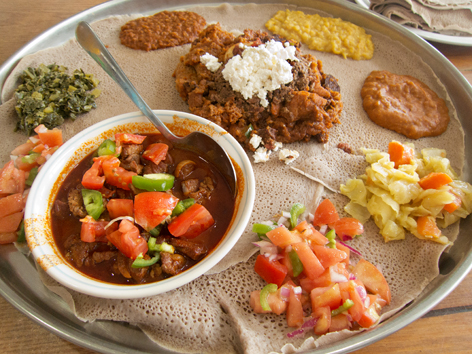Ethiopian Chicken Stew (Doro Wett)
Ethiopia
amantour
guides you to the best local dishes & drinks in
125+ cities. See map now



.jpg) Going somewhere and wish you could take all of a city’s Eat Your World info with you? With EYW’s Kindle and City Guides, you can! Don’t miss out on any local foods or drinks during your next trip.
Going somewhere and wish you could take all of a city’s Eat Your World info with you? With EYW’s Kindle and City Guides, you can! Don’t miss out on any local foods or drinks during your next trip.
EYW wants your food photos!

EYW wants your food stories!
Hey guys I am a traveler who loves to explore different places around the world. I often visit outside of Canada, So whenever I have to travel around the world I always book my flight tickets from the... Read more
<< back to foods in Washington, D.C.

What: It’s said that Washington, D.C. is the second-largest Ethiopian city in the world, second only to Addis Ababa. An estimated 250,000 Ethiopians live here, many of them asylum-seekers from the 1990s, when Ethiopia was engaged in the civil war that led to Eritrea’s independence (interestingly, many who came here as Ethiopians are now Eritrean). Naturally, over time this has meant that a good deal of Ethiopian restaurants have sprung up to serve the needs of these immigrants, and anyone else who wanders in seeking real Ethiopian food—very good news for locals and visitors alike.
For the uninitiated, Ethiopian cuisine features a lot of vegetables, lentils, and spicy meats served atop a giant round of soft spongey flatbread called injera, which gets its tangy taste from its base of water and teff flour (made with a gluten-free, vitamin-rich supergrain indigenous to northeastern Africa), left to ferment for a few days. The injera acts as both plate and eating utensil—using your right hand, you tear off some injera and scoop up your food. It is the most essential part of any Ethiopian meal, quite literally providing its foundation. Understanding that, you can easily experiment with various veggies, lentils, and meats on the menu, from wats (a category of dishes that are, at heart, spicy braised meat and vegetable stews, simmered in niter kibbeh, a spiced clarified butter, and awaze sauce, made with key spice mix berbere) and tibs (another big category of dishes, basically sautéed meat with veggies) to the tartare-like kitfo, a raw-beef dish of lean meat marinated in niter kibbeh and matmita, a finely ground spice containing African bird’s-eye chiles, cardamom seeds, cloves and salt.
Good to know: The “Little Ethiopia” part of town centers around U Street between 9th and 13th Streets; there’s no signage or official designation, however, due to the same area’s important African-American heritage (source).
Where: Family-owned Zenebech Injera (608 T St. NW, map) started life in 1993 as an injera bakery, so you know it’s got some serious cred on the flatbread front. In 1999, it relocated and expanded to offer takeout; now there are a few tables inside and out to accommodate diners, but it’s remained a low-key little hole-in-the-wall. It’s not the place to go for a fancy Ethiopian dinner out, but it is the place to go for very good authentic food.
When: Mon-Sun, 8am-11pm
Order: Pictured, on a bed of injera,is the vegetarian combo ($10); a bowl of awaze tibs with hunks of lamb ($11.75); and a pile of banatu ($11; tibs ferber—beef sautéed with awaze sauce cooked with pieces of injera—mixed with kitfo, homemade ibe (cottage cheese), and a hard-boiled egg) in the center. The veg combo, laid around the outside of the plate, consisted of (clockwise from top) yellow split peas, spicy red lentils, an excellent mix of cabbage-potato-carrot, a tomato and jalapeño salad, collard greens, and spicy shiro, a chickpea stew. It was a lot of food, to say the least, and such a great variety of flavors and textures to keep the taste buds entertained. We particularly loved the rich, deep-red awaze sauce, made here with berbere, oil, garlic, and onion, and the addition of cottage cheese to the banatu, a beautifully cooling element to all the flavor-forward spice. Pair your meal with some Ethiopian honey wine or a Harar-brewed Hakim Stout.
Good to know: Most Ethiopian restaurants in the U.S. serve injera made from a mix of domestic-grown teff flour and wheat flour, as teff is expensive to produce here and it’s banned for export from Ethiopia to keep local prices down in the face of rising global demand. The injera that Zenebech makes daily is this teff-wheat mix, but it’s also one of a small handful of D.C. restaurants to offer “real” injera, imported from Ethiopia and made with 100% teff. (Because of the ban, the bread itself is shipped frozen from Ethiopia.) At Zenebech, you have to request the Ethiopian stuff, which costs an additional $2.50. It’s worth a try—darker in color, it has a thinner, less-spongey consistency (possibly from having been frozen) and a more pronounced sour taste.
Alternatively: Among the beloved Ethiopian options in town are the three-story, picturesque Meskerem (2434 18th St. NW, map), where diners sit on stools around low tables, and live-music venue Dukem (1114-1118 U St. NW, map), where the large menu includes Ethiopian breakfasts. Also near U Street, cozy Etete (1942 9th St NW, map) is a good option, or move over to H Street and try the classy, trendy Ethiopic (401 H St NE, map), which is often cited (in recent years) as being the city’s best in this category.
©2025 Eat Your World, LLC - All Rights Reserved